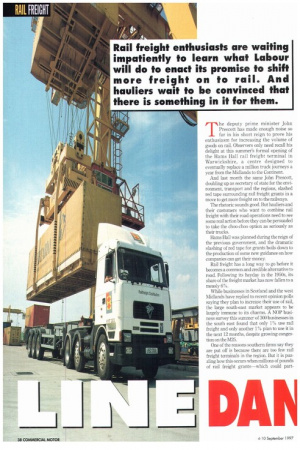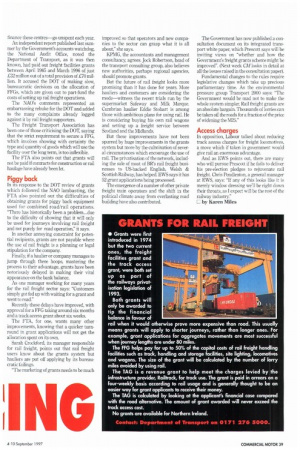Rail freight enthusiasts are waiting impatiently to learn what Labour
Page 40

Page 41

If you've noticed an error in this article please click here to report it so we can fix it.
will do to enact its promise to shift more freight on to rail. And hauliers wait to be convinced that there is something in it for them.
The deputy prime minister John Prescott has made enough noise so far in his short reign to prove his enthusiasm for increasing the volume of goods on rail. Observers only need recall his delight at this summer's formal opening of the Hams IlaII rail freight terminal in Warwickshire, a centre designed to eventually replace a million truck journeys a year from the Midlands to the Continent.
And last month the same John Prescott, doubling up as secretary of state for the environment, transport and the regions, slashed red tape surrounding rail freight grants in a move to get more freight on to the railways.
The rhetoric sounds good. But hauliers and their customers who want to combine rail freight with their road operations need to see some real action before they can be persuaded to take the choo-choo option as seriously as their trucks.
Hams Hall was planned during the reign of the previous government, and the dramatic slashing of red tape for grants boils down to the production of some new guidance on how companies can get their money.
Rail freight has a long way to go before it becomes a common and credible alternative to road. Following its heyday in the 1950s, its share of the freight market has now fallen to a measly 6%.
While businesses in Scotland and the west Midlands have replied to recent opinion polls saying they plan to increase their use of rail, the large south-east market appears to be largely immune to its charms. A NOP business survey this summer of 300 businesses in the south east found that only 1% use rail freight and only another 1% plan to use it in the next 12 months, despite growing congestion on the M25.
One of the reasons southern firms say they are put off is because there are too few rail freight terminals in the region. But it is puzzling how this occurs when millions of pounds of rail freight grants—which could part
finance these centres—go unspent each year.
An independent report published last summer by the Government's accounts watchdog, the National Audit Office, noted the Department of Transport, as it was then known, had paid out freight facilities grants between April 1985 and March 1996 of just £32 million out of a total provision of L70 million. It accused the DOT of making slow, bureaucratic decisions on the allocation of FFGs, which are given out to part-fund the costs of setting up rail freight operations.
The NAO's comments represented an embarrassing rebuke for the DOT and added to the many complaints already logged against it by rail freight supporters.
The Freight Transport Association has been one of those criticising the DOT, saying that the strict requirement to secure a FFG, which involves showing with certainty the type and quantity of goods which will use the facility over the long term, is too inflexible.
The FTA also points out that grants will not be paid if contracts for construction or rail haulage have already been let.
Piggy back
In its response to the DOT review of grants which followed the NAO lambasting, the FTA also pointed out the difficulties of obtaining grants for piggy back equipment used for combined road/rail operations. "There has historically been a problem....due to the difficulty of showing that it will only he used for journeys involving rail freight and not purely for road operation," it says.
In another annoying constraint for potential recipients, grants are not payable where the use of rail freight is a planning or legal stipulation for the company.
Finally, if a haulier or company manages to jump through these hoops, mastering the process to their advantage, grants have been notoriously delayed in making their vital appearance on the bank balance.
As one manager working for many years for the rail freight sector says: "Customers simply got fed up with waiting for a grant and went to road."
Recently these delays have improved, with approval for a FFG taking around six months and a track access grant about six weeks.
The FTA, for one, wants many other improvements, knowing that a quicker turnround in grant applications will not get the allocation spent on its own.
Sarah Crockford, its manager responsible for rail freight, points out that rail freight users know about the grants system but hauliers are put off applying by its bureaucratic failings.
"The marketing of grants needs to be much improved so that operators and new companies to the sector can grasp what it is all about," she says.
KPMG, the accountants and management consultancy, agrees. Jock Robertson, head of the transport consulting group, also believes new authorities, perhaps regional agencies, should promote grants.
But the future of rail freight looks more promising than it has done for years. More hauliers and customers are considering the mode—witness the recent trials run by the supermarket Safeway and Milk Marque. Cumbrian haulier Eddie Stobart is among those with ambitious plans for using rail. He is considering buying his own rail wagons and setting up a freight service between Scotland and the Midlands.
But these improvements have not been spurred by huge improvements in the grants system but more by the culmination of several circumstances which encourage the use of rail. The privatisation of the network, including the sale of most of BR's rail freight businesses to US-backed English, Welsh & Scottish Railway, has helped. EWS says it has 52 grant applications being processed.
The emergence of a number of other private freight train operators and the shift in the political climate away from everlasting road building have also contributed.
The Government has now published a consultation document on its integrated transport white paper, which Prescott says will be inviting views on "whether and how the Government's freight grants scheme might be improved". (Next week CM looks in detail at all the issues raised in the consultation paper).
Fundamental changes to the rules require legislative changes which take up precious parliamentary time As the environmental pressure group Transport 2000 says: "The Government would be mad not to make the whole system simpler. Rail freight grants are an absolute bargain. Thousands of lorries can be taken off the roads for a fraction of the price of widening the M25."
Access charges
In opposition, Labour talked about reducing track access charges for freight locomotives, a move which if taken in government would give rail an enormous advantage.
And as EWS points out, there are many who will pursue Prescott if he fails to deliver his pre-election pledges to rejuvenate rail freight. Chris Pendlenton, a general manager at EWS, says: "If any of this looks like it is merely window dressing we'll be right down their throats, as I expect will be the rest of the railway industry"
by Karen Miles GRAIN' • irlovit RAIL FREIGHT
• Grants were first introduced in 1974 but the two current ones, the freight facilities grant and the track access grant, were both set up as part of the railways privatisation legislation of 1993.
Both grants will only be awarded to tip the financial balance in favour of rail when it would otherwise prove more expensive than road. This usually means grants will apply to shorter journeys, rather than longer ones. For example, grant applications for aggregates movements are most successful when journey lengths are under 80 miles.
The FFG helps pay for up to 50% of the capital costs of rail freight handling facilities such as track, handling and storage facilities, site lighting, locomotives and wagons. The size of the grant will be calculated by the number of lorry miles avoided by using rail.
The TAG is a revenue grant to help meet the charges levied by the infrastructure provider, Railtrack, for track use. The grant is paid in arrears on a four-weekly basis according to rail usage and is generally thought to be an easier way for grant applicants to receive their money.
The TAG is calculated by looking at the applicant's financial case compared with the road alternative. The amount of grant awarded will never exceed the track access cost.
No grants are available for Northern Ireland,








































































































